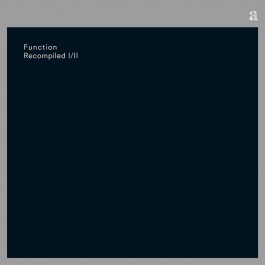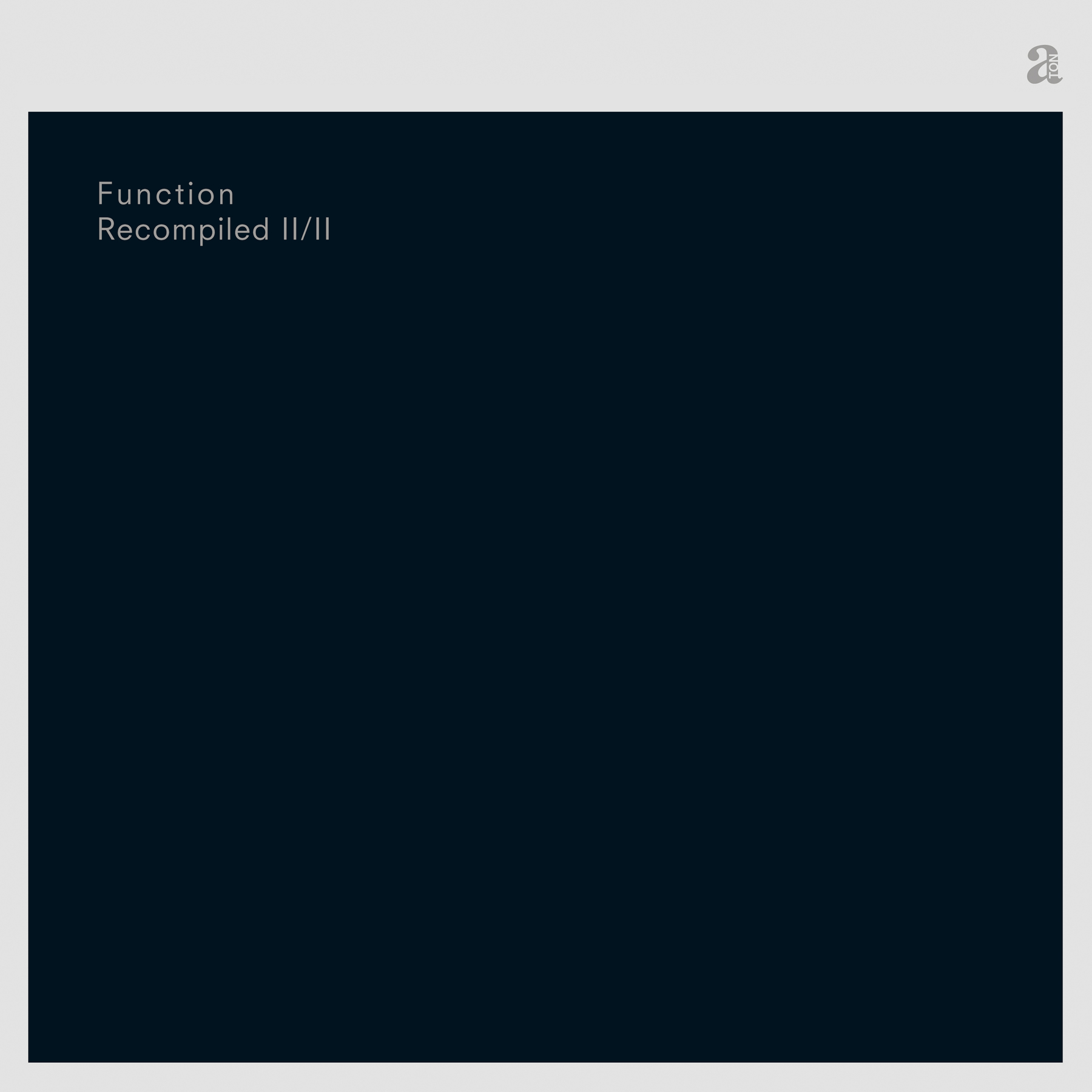Function
Recompiled
[A-TON LP02/03]
All words by Brendan M. Gillen
Interdimensional Transmissions, Detroit, 2017
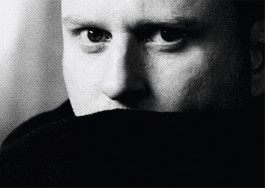
Function by © Sven Marquardt
Future Shock
Once a cathedral, now a mall, Limelight was last in the line of Manhattan clubs whose lineage could be traced back to New York’s fertile club era of the ‘70s and ‘80s, which included the East Village punk and no wave scenes, the Mudd Club, Danceteria and the Paradise Garage. It’s connected to a storied New York history – sometimes holy, sometimes notorious. It’s the last era of mob influence. The spirit of Andy Warhol’s Factory still alive in each club kid’s self-made costume. “A lot of things that were worlds apart met in that deconsecrated Episcopal church,” recalls David Sumner. “I used to practically live in that club, going two or three nights a week for years. I knew this was what I was going to do with the rest of my life.”
In many ways Limelight was America’s rave incubator. On a New Music Seminar night in July of 1992, the revolution was about to take hold. “Walking in, I didn’t know what was going on. Then I started to see xeroxed Underground Resistance 8 1/2 x 11s all around the club, like the kind of inserts that came inside their EPs,” Dave recalls. He would go on to see Mike Banks, Rob “Noise” Hood, and Jeff Mills perform for an electrified crowd as UR. “That night straight up changed my life.”
Jeff Mills held his first residency at Lord Michael’s Future Shock, Friday nights at Limelight, and you can feel the seeds of influence in Function’s sound. In fact it sometimes feels like he’s imagining the DJ booth at Limelight in his own productions; a place where you could find Beltram, Adam X, Program 2, Damon Wild, Patrick Pulsinger, Abe Duque, and even DJ Hell. “The first time I heard Jeff Mills play ‘Der Klang Der Familie’ there I cried. I was totally captivated.”
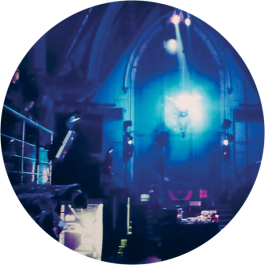
Dave's apartment
251 West 30th Street - Midtown, Manhattan, 1998
251 West 30th Street
With the burning desire to make music, Dave got a job at the best gear store in the city, Rogue Music. Rogue was then located on the 10th floor of The Music Building. He was able to rent a loft on the 15th floor of the building above the practice studios, with panoramic views of Madison Square Garden on one side, and the Empire State on the other. Even living this close to work, he still managed to get fired for being late.
At the store he worked with Dennis Ferrer, who helped Damon Wild with Synewave, where Dave would release his debut record. He recalls watching Dennis meet Kerri Chandler, and receiving KRS-One’s SP-1200, taking it back to the work bench and saying to his friend “this machine is BDP!”
Shortly after, a chance meeting would alter the trajectory of his life. The New Brunswick, New Jersey store Planet X had asked Sumner to host Karl O’Connor, who was set to play in Philadelphia as Regis. Karl had come to town with two of his best friends he’d grown up with, Richard Harvey and Peter Sutton. They all became fast friends, bonding quickly over music and jamming endlessly in his 15th floor loft overlooking the city. Out of these sessions a new collaboration between Karl and Dave would take form, Portion Reform. This would become Sandwell version one. Dave became the first American on the legendary Birmingham, UK-based Downwards label, on a roster with Regis and Surgeon, eventually becoming the Downwards tour DJ.
Sonic Groove Records
41 Carmine Street, Greenwich Village, Manhattan, circa 1990s
Towers of Influence
“The two DJs that made the greatest impact on me are Jeff Mills and Adam X. The first time I saw Adam play he had his hood up over his head, playing a Storm Rave at 5 in the morning, opening with Mike Dunn’s ‘The Pressure Cooker.’” Dave regularly frequented Groove Records out in Bensonhurst, and later when they opened in Manhattan as Sonic Groove. He describes the experience as “the Brooklyn version of intimidating, not the Kreuzberg version,” calling Sonic Groove the Hard Wax of New York.
New York itself is a major influence for Dave, as is its history of clubs – from discos and house music, to techno and raves. Think of Todd Terry’s 1988 Black Riot record or Boyd Jarvis’ 1983 release ‘The Music Got Me’ as milestones on this journey.
“It’s a DJ’s approach to music. I remember in the early ‘90s when the music was changing so rapidly and it felt so revolutionary, separating my records into piles and thinking ‘I need more of this – there needs to be more of this kind of record.’” It’s passion that drives this story of a life in music, and it’s a desire to blow your mind the same way his inspirations blew his. Function is always innovating and finding new ways to connect the dots, to continually pursue the art of storytelling through giant slabs of sound.
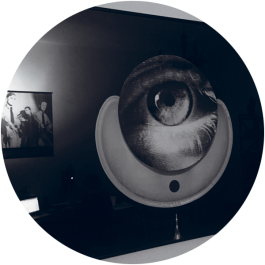
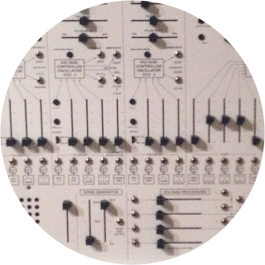
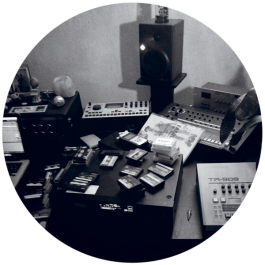
Manhattan to Berlin
Our story has touchstones in Detroit, Birmingham, Sheffield, and Berlin, but it begins with some prophetic foreshadowing in a midnight Manhattan car ride. It was a cold winter night in early 2006, and Dave Sumner, better known as Function, wanted to show me what inspired him, so we got in his car and drove around the perimeter of Manhattan. From the financial district to Harlem, all the city lights, rivers, bridges, and even giant buildings shrunk in comparison to the sounds we were listening to. Dave had found a new path in techno, and as he obsessively talked about the British Murder Boys and the work of Mika Vainio, he focused in on his latest influence: Sleeparchive. As we were listening to a recent Sleeparchive live show, we were basically freaking out at how clearly you could hear the reflected influences, but really how fresh and innovative it felt. Elements of Plastikman’s take on jacking raw rhythms collided with Sähkö bleeps for a powerful post-Jeff Mills form of techno. It was acid without acid. Finally a way forward.
The next year on a humid summer night in Berlin, Dave and Karl O’Connor, better known as Regis, were sitting with their laptops back to back at 2 am in his apartment. “They were set up Battleship style, it was like the cover to Upstairs at Eric’s,” recalls Dave. He was playing Karl selections of his new music when Karl stopped him and said, “This is your new record.” They worked through the night and within a day the record was done; Dave was so inspired he decided to move there, to “techno Mecca.” He returned to NYC to get ready, and three months later, on the day he moved to Berlin, his record was released as Isolation on Sandwell District and was named DJ Magazine’s 12 Inch of the Month. He then set up his studio in the warehouse of Tony Vieira, who had run Integrale Muzique with Karl, and is literally surrounded by records. He makes his new records with those records doubling as his soundproofing and audience.
Function - Isolation [SD07, 2007]
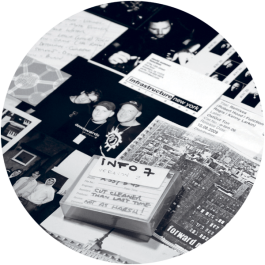
Sandwell District
Sandwell District is a literal place — the Black Country — where the industrial revolution began. It’s one of the many Dadaesque references in the Integrale catalog. The whole thing has this major punk DIY spirit, best characterized by the line from the Desperate Bicycles: “it was easy, it was cheap, go and do it!”
Sandwell District quickly evolved from a label into a music project with a distinctly egoless and mysterious approach. They functioned around the motto of “Decentralizing the artist ego, blurring the lines between the artist, label and DJ; re-arranging the DNA of modern dance music.”
The first record on Sandwell was by Regis, followed by records from Juan Mendez as Silent Servant and Dave as Function; soon they would all release collectively. Sandwell District was a more mature response, the second stage of a career with the disparate influences absorbed, digested, and slowed down, yet somehow more emotional. The combined musical knowledge of these three was magic; all bases were covered. Juan created the powerful visual language of Sandwell and was the glue, while Karl and Dave became the engine driving Sandwell District live.
Sandwell peaked with some legendary live shows, from closing the mainstage at Sonar to playing the Park Hill Flats in Sheffield for Black Dog, with Cabaret Voltaire’s Richard H Kirk pogoing onstage during the performance. Later, Rrose would become an integral part of Sandwell, right before they broke up at the height of their popularity, in the spirit of their heroes Big Black. “It was a glorious death, not a mercy killing, as is so often the case in these situations,” Sandwell said through a statement from Silent Servant. Dave then went on to record his debut solo album Incubation for Ostgut Ton and revived Infrastructure.
The Next Phase
Sometimes the only way forward is to look backwards. Those who cannot remember the past are condemned to repeat it, as the saying goes. So what you hold in your hands, Recompiled I/II & II/II, is an attempt to understand what has happened and to liberate the artist from the burden of their own oeuvre.
Moving forward, Function is still connecting the dots with his DJing around the globe, with residencies at Berghain in Berlin and Bassani in Tbilisi, Georgia. Collaborations with techno super heroes continue, in projects like LSD with Luke Slater and Steve Bicknell and his work with Damon Wild. Who knows what the future holds? New music, new collaborations, new developments in sound — places for new ideas to thrive.
In Detroit, we wanted to see society evolve; Detroit Techno was about the future. Techno at Berghain is about losing yourself; it’s about personal freedom. Function has created the perfect soundtrack for that experience. “Techno is reflective,” according to Dave. “It taps into another emotion that nothing else gives me.”

LSD in session, 2016
pictured left to right: David Sumner, Steve Bicknell, Luke Slater
Function
Recompiled
[A-TON LP02/03]
All words by Brendan M. Gillen
Interdimensional Transmissions, Detroit, 2017

Function by © Sven Marquardt
Future Shock
Once a cathedral, now a mall, Limelight was last in the line of Manhattan clubs whose lineage could be traced back to New York’s fertile club era of the ‘70s and ‘80s, which included the East Village punk and no wave scenes, the Mudd Club, Danceteria and the Paradise Garage. It’s connected to a storied New York history – sometimes holy, sometimes notorious. It’s the last era of mob influence. The spirit of Andy Warhol’s Factory still alive in each club kid’s self-made costume. “A lot of things that were worlds apart met in that deconsecrated Episcopal church,” recalls David Sumner. “I used to practically live in that club, going two or three nights a week for years. I knew this was what I was going to do with the rest of my life.”
In many ways Limelight was America’s rave incubator. On a New Music Seminar night in July of 1992, the revolution was about to take hold. “Walking in, I didn’t know what was going on. Then I started to see xeroxed Underground Resistance 8 1/2 x 11s all around the club, like the kind of inserts that came inside their EPs,” Dave recalls. He would go on to see Mike Banks, Rob “Noise” Hood, and Jeff Mills perform for an electrified crowd as UR. “That night straight up changed my life.”
Jeff Mills held his first residency at Lord Michael’s Future Shock, Friday nights at Limelight, and you can feel the seeds of influence in Function’s sound. In fact it sometimes feels like he’s imagining the DJ booth at Limelight in his own productions; a place where you could find Beltram, Adam X, Program 2, Damon Wild, Patrick Pulsinger, Abe Duque, and even DJ Hell. “The first time I heard Jeff Mills play ‘Der Klang Der Familie’ there I cried. I was totally captivated.”
251 West 30th Street
With the burning desire to make music, Dave got a job at the best gear store in the city, Rogue Music. Rogue was then located on the 10th floor of The Music Building. He was able to rent a loft on the 15th floor of the building above the practice studios, with panoramic views of Madison Square Garden on one side, and the Empire State on the other. Even living this close to work, he still managed to get fired for being late.
At the store he worked with Dennis Ferrer, who helped Damon Wild with Synewave, where Dave would release his debut record. He recalls watching Dennis meet Kerri Chandler, and receiving KRS-One’s SP-1200, taking it back to the work bench and saying to his friend “this machine is BDP!”
Shortly after, a chance meeting would alter the trajectory of his life. The New Brunswick, New Jersey store Planet X had asked Sumner to host Karl O’Connor, who was set to play in Philadelphia as Regis. Karl had come to town with two of his best friends he’d grown up with, Richard Harvey and Peter Sutton. They all became fast friends, bonding quickly over music and jamming endlessly in his 15th floor loft overlooking the city. Out of these sessions a new collaboration between Karl and Dave would take form, Portion Reform. This would become Sandwell version one. Dave became the first American on the legendary Birmingham, UK-based Downwards label, on a roster with Regis and Surgeon, eventually becoming the Downwards tour DJ.
Towers of Influence
“The two DJs that made the greatest impact on me are Jeff Mills and Adam X. The first time I saw Adam play he had his hood up over his head, playing a Storm Rave at 5 in the morning, opening with Mike Dunn’s ‘The Pressure Cooker.’” Dave regularly frequented Groove Records out in Bensonhurst, and later when they opened in Manhattan as Sonic Groove. He describes the experience as “the Brooklyn version of intimidating, not the Kreuzberg version,” calling Sonic Groove the Hard Wax of New York.
New York itself is a major influence for Dave, as is its history of clubs – from discos and house music, to techno and raves. Think of Todd Terry’s 1988 Black Riot record or Boyd Jarvis’ 1983 release ‘The Music Got Me’ as milestones on this journey.
“It’s a DJ’s approach to music. I remember in the early ‘90s when the music was changing so rapidly and it felt so revolutionary, separating my records into piles and thinking ‘I need more of this – there needs to be more of this kind of record.’” It’s passion that drives this story of a life in music, and it’s a desire to blow your mind the same way his inspirations blew his. Function is always innovating and finding new ways to connect the dots, to continually pursue the art of storytelling through giant slabs of sound.
Manhattan to Berlin
Our story has touchstones in Detroit, Birmingham, Sheffield, and Berlin, but it begins with some prophetic foreshadowing in a midnight Manhattan car ride. It was a cold winter night in early 2006, and Dave Sumner, better known as Function, wanted to show me what inspired him, so we got in his car and drove around the perimeter of Manhattan. From the financial district to Harlem, all the city lights, rivers, bridges, and even giant buildings shrunk in comparison to the sounds we were listening to. Dave had found a new path in techno, and as he obsessively talked about the British Murder Boys and the work of Mika Vainio, he focused in on his latest influence: Sleeparchive. As we were listening to a recent Sleeparchive live show, we were basically freaking out at how clearly you could hear the reflected influences, but really how fresh and innovative it felt. Elements of Plastikman’s take on jacking raw rhythms collided with Sähkö bleeps for a powerful post-Jeff Mills form of techno. It was acid without acid. Finally a way forward.
The next year on a humid summer night in Berlin, Dave and Karl O’Connor, better known as Regis, were sitting with their laptops back to back at 2 am in his apartment. “They were set up Battleship style, it was like the cover to Upstairs at Eric’s,” recalls Dave. He was playing Karl selections of his new music when Karl stopped him and said, “This is your new record.” They worked through the night and within a day the record was done; Dave was so inspired he decided to move there, to “techno Mecca.” He returned to NYC to get ready, and three months later, on the day he moved to Berlin, his record was released as Isolation on Sandwell District and was named DJ Magazine’s 12 Inch of the Month. He then set up his studio in the warehouse of Tony Vieira, who had run Integrale Muzique with Karl, and is literally surrounded by records. He makes his new records with those records doubling as his soundproofing and audience.
Sandwell District
Sandwell District is a literal place — the Black Country — where the industrial revolution began. It’s one of the many Dadaesque references in the Integrale catalog. The whole thing has this major punk DIY spirit, best characterized by the line from the Desperate Bicycles: “it was easy, it was cheap, go and do it!”
Sandwell District quickly evolved from a label into a music project with a distinctly egoless and mysterious approach. They functioned around the motto of “Decentralizing the artist ego, blurring the lines between the artist, label and DJ; re-arranging the DNA of modern dance music.”
The first record on Sandwell was by Regis, followed by records from Juan Mendez as Silent Servant and Dave as Function; soon they would all release collectively. Sandwell District was a more mature response, the second stage of a career with the disparate influences absorbed, digested, and slowed down, yet somehow more emotional. The combined musical knowledge of these three was magic; all bases were covered. Juan created the powerful visual language of Sandwell and was the glue, while Karl and Dave became the engine driving Sandwell District live.
Sandwell peaked with some legendary live shows, from closing the mainstage at Sonar to playing the Park Hill Flats in Sheffield for Black Dog, with Cabaret Voltaire’s Richard H Kirk pogoing onstage during the performance. Later, Rrose would become an integral part of Sandwell, right before they broke up at the height of their popularity, in the spirit of their heroes Big Black. “It was a glorious death, not a mercy killing, as is so often the case in these situations,” Sandwell said through a statement from Silent Servant. Dave then went on to record his debut solo album Incubation for Ostgut Ton and revived Infrastructure.
The Next Phase
Sometimes the only way forward is to look backwards. Those who cannot remember the past are condemned to repeat it, as the saying goes. So what you hold in your hands, Recompiled I/II & II/II, is an attempt to understand what has happened and to liberate the artist from the burden of their own oeuvre.
Moving forward, Function is still connecting the dots with his DJing around the globe, with residencies at Berghain in Berlin and Bassani in Tbilisi, Georgia. Collaborations with techno super heroes continue, in projects like LSD with Luke Slater and Steve Bicknell and his work with Damon Wild. Who knows what the future holds? New music, new collaborations, new developments in sound — places for new ideas to thrive.
In Detroit, we wanted to see society evolve; Detroit Techno was about the future. Techno at Berghain is about losing yourself; it’s about personal freedom. Function has created the perfect soundtrack for that experience. “Techno is reflective,” according to Dave. “It taps into another emotion that nothing else gives me.”
